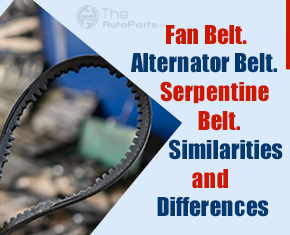You can often find the following description of a “fan belt” in any current automotive dictionary: “An endless belt used to convey power from a crankshaft-driven pulley to a pulley operating the fan, alternator, or other engine accessories.” It typically has a cross-section formed like a V, and the point of the vee fits into a groove in the pulley. The word “fan belt” is wrongly used as a general term to describe any single accessory belt that may be used to drive a water pump, alternator, power steering pump, or other components, even though cooling fans on the majority of current cars are driven by electric motors rather than real belts. Why?
A cooling fan (or fans) must be installed at the front of the car, right behind the radiator, to draw cold air through the radiator. Crankshaft pulley wheels, which are convenient sources of power for cooling fans, are located right there at the front of traditional rear-wheel-drive cars with longitudinally mounted engines. The statement became commonplace for any belts that appeared similar, regardless of what purpose they served, because the fan belt often tended to be the largest and most prominent one on the vehicle. The statement was made even more popular by the fact that several early engine designs employed that fan belt to turn the pulleys for the water pump and alternator.
The “front” of the engine, where the cooling fan resided, is no longer at the front of the car as front-wheel-drive & sideways-mounted engines gained popularity.
Fan belts were no longer required as engineers improved electric motors, temperature sensors, & associated computers. Electric motors with automatic shutoff have shown to be more energy-efficient than direct drive belts with constant connection since cooling fans don’t constantly need to be running at stable cruising speeds. The phrase “fan belt” is practically outdated today because electric cooling fans are utilized even in contemporary automobiles with conventional longitudinally mounted engines. When looking for a replacement single belt of any sort, auxiliary belt or V-belt are better terms to use.
Belts are built similarly to tyres since they are both susceptible to continual rotation, stress, and heat. Internal steel & cord reinforcements are enclosed by an exterior layer of rubber to reduce stretching and provide strength when grip is required under stress.
ACCESSORY BELTS
Automotive auxiliary belts that are installed externally to the engine are also referred to as “V-belts” because of the way their trapezoidal shape narrows from broad to narrow at the bottom to form a V point. In order to avoid sideways slippage, the underside of the belt has infinite parallel ridges that fit into matching grooves on the pulley wheel, also known as sheaves. Rubber grooves on this kind of V-belt wedge further into the pulley sheaves as load pressures rise, and friction creates the necessary grip.
The position of an idler pulley wheel can be changed manually by tightening an adjustment, or accessories like an alternator or air conditioner compressor can be moved by a minuscule amount by adjusting slotted mounting brackets.
The Vee requires less breadth and less tension than flat belts or other types thanks to these design advantages, making it one of the most practical belt choices. They work well with accessories that switch on and off using a clutch, including air conditioner compressors and earlier models of radiator cooling fans since they may offer a tiny amount of slippage when necessary.
These belts are used for accessories installed outside the engine, such as power steering pumps, alternators, auxiliary air pumps, as well as other devices. They may or may not have many grooves. Some automakers may use a different belt for each accessory, while others may arrange their pulley wheels such that only a few belts are connected to several pulley wheels.
SERPENTINE BELTS
Simply said, a serpentine belt is an unending belt that is longer and made in the same way as an auxiliary belt. A serpentine belt is made to wound around numerous pulley wheels rather than being unique to one accessory. It powers a car’s alternator, air conditioner compressor, power steering pump, and sometimes even the water pump or cooling fan. A serpentine belt may have friction on either one or both sides. The belt is redirected at several spots to the direction of the next accessory using freewheeling “idler pulley” wheels.
Serpentine belts, as opposed to separate belts, are kept tight by an idler pulley wheel that is constantly pressed by a powerful spring-loaded tensioner. If a serpentine belt has to be removed or changed, a correct set of hand tools must be used to provide force to the belt tensioner, which will then release its tension.
TIMING BELTS
Timing belts and auxiliary belts are two different things. Timing belts are housed inside the engine, as opposed to fan belts, serpentine belts, or any other auxiliary belts that power accessories installed on the exterior of the engine. They are flatter in structure and have bottom grooves with teeth that fit camshaft driving gears.
This style of belt maintains consistent tension from a spring-loaded pulley, keeping it slip-proof and able to run at the set speed required for precise camshaft timing. This identical toothed configuration and design are typically used in belts that drive superchargers. When slippage is required for clutches that activate & deactivate, toothed belts—also referred to as notched or cog-type belts—cannot be utilized, unlike friction belts.
Purchasing Replacement Accessory Belts
The terms auxiliary drive belt, V belt, or serpentine belt is more appropriate than the terms fan belt, alternator belt, or water pump belt.
Depending on the engine and other attachments, every vehicle has a unique belt arrangement.
Knowing your car’s year, make, & model, engine size, and in some circumstances whether or not it has particular equipment like air conditioning is crucial when buying new belts.
Making sure you get the right belt requires knowing these few details beforehand. For more visit The Autoparts Shop now!!
